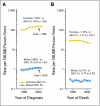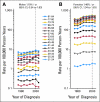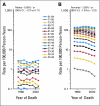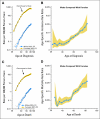Male breast cancer: a population-based comparison with female breast cancer
- PMID: 19996029
- PMCID: PMC2815713
- DOI: 10.1200/JCO.2009.23.8162
Male breast cancer: a population-based comparison with female breast cancer
Abstract
Purpose: Because of its rarity, male breast cancer is often compared with female breast cancer.
Patients and methods: To compare and contrast male and female breast cancers, we obtained case and population data from the National Cancer Institute's Surveillance, Epidemiology, and End Results program for breast cancers diagnosed from 1973 through 2005. Standard descriptive epidemiology was supplemented with age-period-cohort models and breast cancer survival analyses.
Results: Of all breast cancers, men with breast cancer make up less than 1%. Male compared with female breast cancers occurred later in life with higher stage, lower grade, and more estrogen receptor-positive tumors. Recent breast cancer incidence and mortality rates declined over time for men and women, but these trends were greater for women than for men. Comparing patients diagnosed from 1996 through 2005 versus 1976 through 1985, and adjusting for age, stage, and grade, cause-specific hazard rates for breast cancer death declined by 28% among men (P = .03) and by 42% among women (P approximately 0).
Conclusion: There were three intriguing results. Age-specific incidence patterns showed that the biology of male breast cancer resembled that of late-onset female breast cancer. Similar breast cancer incidence trends among men and women suggested that there are common breast cancer risk factors that affect both sexes, especially estrogen receptor-positive breast cancer. Finally, breast cancer mortality and survival rates have improved significantly over time for both male and female breast cancer, but progress for men has lagged behind that for women.
Conflict of interest statement
Authors' disclosures of potential conflicts of interest and author contributions are found at the end of this article.
Figures





References
-
- Jemal A, Siegel R, Ward E, et al. Cancer statistics, 2008. CA Cancer J Clin. 2008;58:71–96. - PubMed
-
- Tischkowitz MD, Hodgson SV, Fentiman IS. 19. Male breast cancer: Aetiology, genetics and clinical management. Int J Clin Pract. 2002;56:750–754. - PubMed
-
- Giordano SH. Male breast cancer: It's time for evidence instead of extrapolation. Onkologie. 2008;31:505–506. - PubMed
-
- English JC, 3rd, Middleton C, Patterson JW, et al. Cancer of the male breast. Int J Dermatol. 2000;39:881–886. - PubMed
-
- Berry DA, Ravdin PM. Breast cancer trends: A marriage between clinical trial evidence and epidemiology. J Natl Cancer Inst. 2007;99:1139–1141. - PubMed
Publication types
MeSH terms
Substances
Grants and funding
LinkOut - more resources
Full Text Sources
Medical

